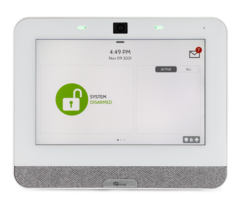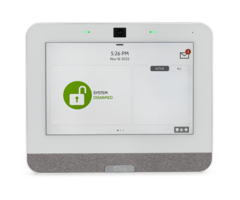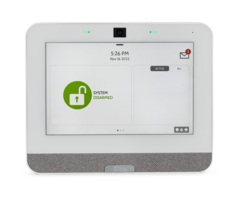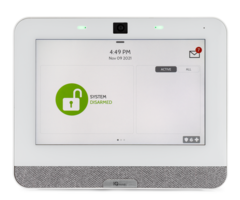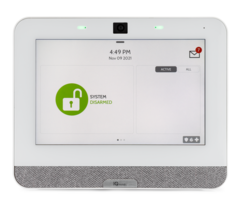The Sensor Group setting in the Qolsys IQ Panel 4 tells the panel how the zone is treated. Is it active when armed Away, armed Stay, or both? Is it always active, such as when a life-safety detector is used? The Sensor Group answers these questions. Here, we'll cover each possible setting.
When programming zones in a Qolsys IQ Panel 4, one of the settings you will have to determine is the Sensor Group. It may not be obvious at first what's expected here, but this setting tells the panel how each individual zone should behave and be treated by the system.
For example, a zone programmed with an interior sensor group setting may automatically be bypassed when the system is armed in the Stay Mode. A smoke detector will be active, regardless of whether the system is armed or disarmed. The Sensor Group setting is one of the most important things you will program in your system for each zone.
The Sensor Group programming section of the panel begins in the Installation Manual on Page 66. It is divided by sensor type, for example there is a section for Door/Window Sensors, for Motion Sensors, Glass Break Sensors, and so on. In some cases, when the panel learns in a sensor, it knows whether that sensor is a Door/Window or a Motion Sensor. In those cases, the panel will only provide available Sensor Groups for programming that match the sensor type. In certain cases, this can't be changed without changing the Sensor Type, and in some cases, the panel won't allow you to do even that, so bear all that in mind.
Below are jump links for each programming section, based on sensor type:
Note: SRF433 is not for EN Grade 2 Installations. SRF319 and SRF345 are not for UKCA or CE/EN Grade 2 Installations.
| Sensor Group
|
Name
|
Supervised
|
Description
|
| 10
|
Entry/Exit - Normal Delay
|
Y
|
Provides both Exit and Entry Delay time when arming and disarming the system.
|
| 11
|
Day Zone
|
Y
|
Provides Instant Alarm when the system is armed (like Group 13). When disarmed, announces opens and closes and will continue to notify until the Dismiss button is pressed.
|
| 12
|
Entry/Exit - Long Delay
|
Y
|
Provides both Exit and Entry Delay time when arming and disarming the system. This can be a different amount of time, usually longer, than the normal delay. Use this on an entry or exit door that is further away from the panel or keypad.
|
| 13
|
Instant Perimeter - D/W
|
Y
|
Door or window that provides an Instant Alarm when the system is armed. Does not provide either an Entry or an Exit delay.
|
| 14
|
Instant Interior Door
|
Y
|
Active in both Stay and Away, provides an Instant Alarm if activated first. Provides a delay if activated after an Entry/Exit zone has been tripped.
|
| 16
|
Away Instant - Follower Delay
|
Y
|
Active in Away Mode only, provides an Instant Alarm. Faulting an Entry/Exit zone first will cause this zone to provide a delay also.
|
| 25
|
Local Safety Sensor
|
Y
|
Local notification only. This setting never reports or triggers an alarm. This is a chime only sensor when “Activity Monitoring” is active, regardless of armed status. Used to secure medicine cabinets, liquor cabinets, hazardous areas, etc.
Activity Monitoring is Enabled by default. Find it by tapping the gray bar at the top of the screen, then Settings > Advanced Settings > Enter Installer or Dealer Code (1111 or 2222 by default respectively) > Sounds.
|
| 8
|
Reporting Safety Sensor
|
Y
|
Similar to Sensor Group 25, but this one reports and triggers an alarm when "Activity Monitoring" is enabled, regardless of the panel's armed status.
|
| 9
|
Delayed Reporting Safety Sensor
|
Y
|
Similar to Sensor Group 25 and 8, but with an Entry Delay. This Sensor Group reports and activates an alarm when "Activity Monitoring" is enabled, regardless of the panel's armed status, but provides an Entry Delay period before causing an alarm.
|
| 345 MHz door/window sensors will have the option to change the “Loop” number to 1 or 2. This will allow the sensor to be programmed twice as 2 separate zones.
|
| Power G Door/Window contacts PGx945, PGx309, PGx312 add an additional drop down menu to determine the contact type, Reed Switch or Wired.
|
| Sensor Group
|
Name
|
Supervised
|
Description
|
| 17
|
Away-Instant Motion
|
Y
|
Active in Away and Night only. When tripped first, provides an Instant Alarm. Does not trip if an Entry/Exit sensor is tripped first.
|
| 15
|
Stay-Instant Motion
|
Y
|
Active in Stay, Away, and Night modes. When tripped first, provides an Instant Alarm. Does not trip if an Entry/Exit sensor is tripped first.
|
| 35
|
Stay-Delay Motion
|
Y
|
Active in Stay, Away, and Night modes. When tripped first provides an Entry Delay. Does not trip if an Entry/Exit sensor is tripped first.
|
| 20
|
Away-Delay Motion
|
Y
|
Active in Away and Night only. If tripped first, provides an Entry Delay. Does not trip if an Entry/Exit sensor is tripped first.
|
| 21
|
Night Motion
|
Y
|
Active in Away only. When tripped first, provides an Instant Alarm. Does not trip if an Entry/Exit sensor is tripped first.
|
| 25
|
Safety Motion
|
Y
|
Does not report or trigger an alarm. This is a Chime-Only sensor when "Activity Monitoring" is enabled regardless of panel's armed status. Used for Medicine Cabinets, Activity Tracking, Storage, etc.
|
| 43
|
Away-Instant, Stay-Delay Motion
|
Y
|
Active in Stay, Night, and Away Modes. If tripped first in Away Mode (and presumably Night Mode) it causes an Instant Alarm. Does not trip if an Entry/Exit Zone is tripped first. In Stay Mode it activates an Entry Delay when tripped first.
|
| 44
|
Away-Instant Interior Motion
|
Y
|
Active in Night and Away Modes. Always causes an Instant Alarm when tripped even if an Entry/Exit zone is tripped first.
|
| 45
|
Away-Instant Interior Motion
|
Y
|
Active in Stay, Night and Away Modes. Always causes an Instant Alarm when tripped even if an Entry/Exit zone is tripped first.
|
| 345 MHz motion sensors may have the option to change the “Loop” number to 1, 2 or 3. When supported by the motion sensor, this may allow the sensor to be programmed twice as 2 separate zones.
|
| Power G Motion Detectors with Serial Number Prefix 120, 122, 130, 140, and 142 offer additional capabilities such as High Traffic Shutdown and Sensitivity Level. Motions with Serial Number Prefix 123, 126, 127, 128, and 129 offer only High Traffic Shutdown as an additional function.
|
| Sensor Group
|
Name
|
Supervised
|
Description
|
| 13
|
Glass Break
|
Y
|
Active in Stay and Away Mode.
|
| 17
|
Glass Break - Away Only
|
Y
|
only active in Away Mode.
|
| 345 MHz glass break sensors can be programmed as “Loop” 1 only.
|
| Sensor Group
|
Name
|
Supervised
|
Description
|
| 1
|
Mobile Intrusion
|
N
|
To be Worn or Carried. Triggers an Audible Police panic.
|
| 3
|
Mobile Silent
|
N
|
To be Worn or Carried. Triggers a Silent Police panic.
|
| 4
|
Fixed Auxiliary
|
Y
|
Mounted in a Fixed Location such as a night stand. Triggers an Audible Auxiliary (Medical) panic. NOTE: Medical functionality has not been evaluated for UL/cUL, UKCA or CE/EN Grade 2.
|
| 5
|
Fixed Silent Auxiliary
|
Y
|
Mounted in a Fixed Location such as a night stand. Triggers a Silent Auxiliary (Medical) panic. NOTE: Medical functionality has not been evaluated for UL/cUL, UKCA or CE/EN Grade 2.
|
| 6
|
Mobile Auxiliary
|
N
|
To be Worn as a wrist watch or a pendant. Triggers an Audible Auxiliary (Medical) panic. NOTE: Medical functionality has not been evaluated for UL/cUL, UKCA or CE/EN Grade 2.
|
| 7
|
Mobile Silent Auxiliary
|
N
|
To be Worn as a wrist watch or a pendant. Triggers a Silent Auxiliary (Medical) panic. NOTE: Medical functionality has not been evaluated for UL/cUL, UKCA or CE/EN Grade 2.
|
| 345 MHz Keyfobs will follow the IQ Panel’s Keyfob programming and functionality.
|
| Sensor Group
|
Name
|
Supervised
|
Description
|
| 0
|
Fixed Intrusion
|
Y
|
Installed in a Fixed Location. Triggers an Audible Police panic. NOTE: Hold-up functionality has not been evaluated for UL/cUL, UKCA or CE/EN Grade 2.
|
| 1
|
Mobile Intrusion
|
N
|
Keypad can be Mobile. Programmed to trigger an Audible Police panic.
|
| 2
|
Fixed Silent
|
Y
|
Installed in a Fixed Location. Programmed to trigger a Silent Police panic.
|
| 3
|
Mobile Silent
|
N
|
Keypad can be Mobile. Programmed to trigger a Silent Police panic.
|
| 4
|
Fixed Auxiliary
|
Y
|
Installed in a Fixed Location. Programmed to trigger an Audible Auxiliary (Medical) panic. NOTE: Medical functionality has not been evaluated for UL/cUL, UKCA or CE/EN Grade 2.
|
| 5
|
Fixed Silent Auxiliary
|
Y
|
Installed in a Fixed Location. Programmed to trigger a Silent Auxiliary (Medical) panic. NOTE: Medical functionality has not been evaluated for UL/cUL, UKCA or CE/EN Grade 2.
|
| 6
|
Mobile Auxiliary
|
N
|
Keypad can be Mobile. Programmed to trigger an Audible Auxiliary (Medical) panic. NOTE: Medical functionality has not been evaluated for UL/cUL, UKCA or CE/EN Grade 2.
|
| 7
|
Mobile Silent Auxiliary
|
N
|
Keypad can be Mobile. Programmed to trigger a Silent Auxiliary (Medical) panic. NOTE: Medical functionality has not been evaluated for UL/cUL, UKCA or CE/EN Grade 2.
|
| Sensor Group
|
Name
|
Supervised
|
Description
|
| 0
|
Fixed Intrusion
|
Y
|
Button is installed in a Fixed Location. Triggers an Audible Police panic.
|
| 2
|
Fixed Silent
|
Y
|
Button is installed in a Fixed Location. Programmed to trigger a Silent Police panic.
|
| 3
|
Mobile Silent
|
N
|
Button can be Mobile. Programmed to trigger a Silent Police panic.
|
| 4
|
Fixed Auxiliary
|
Y
|
Button is installed in a Fixed Location. Programmed to trigger an Audible Auxiliary (Medical) panic.
|
| 5
|
Fixed Silent Auxiliary
|
Y
|
Button is installed in a Fixed Location. Programmed to trigger a Silent Auxiliary (Medical) panic.
|
| 6
|
Mobile Auxiliary
|
N
|
Button can be Mobile. Programmed to trigger an Audible Auxiliary (Medical) panic.
|
| 7
|
Mobile Silent Auxiliary
|
N
|
Keypad can be Mobile. Programmed to trigger an Silent Auxiliary (Medical) panic.
|
| 25
|
Safety Auxiliary Pendant
|
N
|
Used for local alerts, like a nurse call button. Does not report an alarm to central station. NOTE: Medical functionality has not been evaluated for UL/cUL, UKCA or CE/EN Grade 2.
|
| 61
|
Fixed Intrusion Restore
|
Y
|
Button is installed in a Fixed Location such as under a counter or desk. Programmed to trigger an Audible Police Panic. Sends a restore report to central station. Most often used with a latching panic button.
|
| 62
|
Fixed Silent Restore
|
Y
|
Button is installed in a Fixed Location such as under a counter or desk. Programmed to trigger a Silent Police Panic. Sends a restore report to central station. Most often used with a latching panic button.
|
| 345 MHz auxiliary pendants can be programmed as “Loop” 1 only.
|
| Sensor Group
|
Name
|
Supervised
|
Description
|
| 26
|
Smoke - Heat
|
Y
|
Triggers a Fire Alarm when the sensor detects smoke or a rapid rise in heat.
|
| 345 MHz smoke sensors will have the option to change the “Loop” number to 1, 2 or 3. This will allow the sensor to be programmed twice as 2 different zones where supported by the device.
|
| Sensor Group
|
Name
|
Supervised
|
Description
|
| 26
|
Smoke - Heat
|
Y
|
Triggers a Fire Alarm when the sensor detects smoke or a rapid rise in heat. Use only this Sensor Group with Qolsys multi-sensor smoke (QS5110-840)
|
| Sensor Group
|
Name
|
Supervised
|
Description
|
| 34
|
CO
|
Y
|
Triggers a Carbon Monoxide Alarm when the sensor detects sufficient quantities of Carbon Monoxide gas.
|
| *345 MHz carbon monoxide sensors can be programmed as “Loop” 1 only.
|
| Sensor Group
|
Name
|
Supervised
|
Description
|
| 13
|
Takeover
|
Y
|
Triggers an alarm if the module is tampered in Stay or Away Mode.
|
| Sensor Group
|
Name
|
Supervised
|
Description
|
| 10
|
Entry/Exit - Normal Delay
|
Y
|
Triggers the alarm when tripped after the Normal Delay expires. Armed in both Stay and Away arming modes.
|
| 12
|
Entry/Exit - Long Delay
|
Y
|
Triggers the alarm when tripped after the Long Delay expires. Armed in both Stay and Away arming modes.
|
| 25
|
Garage Tilt - Safety Tilt
|
Y
|
This sensor group does not trigger an alarm or report. This is a chime only sensor when “Activity Monitoring” is enabled, regardless of panel armed status. Great for detached garages/shops. NOTE: Functionality in conjunction with garage door openers has not been evaluated for UL/cUL, UKCA or CE/EN Grade 2.
|
| 345 MHz tilt sensors can be programmed as “Loop” 3 only.
|
| Sensor Group
|
Name
|
Supervised
|
Description
|
| 38
|
Water Sensor
|
Y
|
Triggers an alarm when the sensor signals the presence of water in sufficient quantities, and/or for a sufficient period of time. NOTE: flood sensor functionality has not been evaluated for UL/cUL, UKCA or CE/EN Grade 2.
|
| 25
|
Water Non-Reporting
|
Y
|
Provides a local alert only, no report is generated to the central station.
|
|
Please note: When selecting “Water” you will see two additional options under “Sensor Sub-Type”. For IQ TempH20 (QS5500-PO1) & the IQ Flood (QS5516-840/QS5536-840) select “IQ Flood.” For all others, select “Other Flood.”
|
| 345 MHz water sensors will have the option to change the “Loop” number to 1, 2 or 3. This will allow the sensor to be programmed twice as 2 different zones where supported by the device.
|
| Sensor Group
|
Name
|
Supervised
|
Description
|
| 13
|
Shock-Glass-Break
|
Y
|
Arms and trips shock sensors instantly when armed to both Stay and Away
|
| 17
|
Glass-Break-Away Only
|
Y
|
Arms and trips shock sensors instantly when armed to Away
|
| Sensor Group
|
Name
|
Supervised
|
Description
|
| 52
|
Freeze
|
Y
|
Triggers an alarm when the sensor detects low temperature. NOTE: temperature sensor functionality has not been evaluated by UL/cUL.
|
| 25
|
Freeze Non-Reporting
|
Y
|
Triggers a local alert when the sensor detects low temperature. Used for local alert only, will not report to central station.
|
|
Please note: When using the PGx905 with Group 52, Freeze, the Low threshold setting is set to 40°F (4°C) by default. The Low threshold can be customized between -22°F and 158°F (-40°C and 85°C).
|
| 345 MHz shock sensors will have the option to change the “Loop” number to 1 or 3. This will allow the sensor to be programmed twice as 2 different zones where supported by the device.
|
| Sensor Group
|
Name
|
Supervised
|
Description
|
| 53
|
Temp - Reporting
|
Y
|
Triggers an alarm when the sensor detects high temperature. NOTE: temperature sensor functionality has not been evaluated by UL/cUL.
|
| 25
|
Temp Non-Reporting
|
Y
|
Triggers a local alert when the sensor detects high temperature. Used for local alert only, will not report to central station.
|
|
Please note: When using the PGx905 with Group 53, the High threshold setting is set to 100°F (38°C) by default. The High threshold can be customized between -22°F and 158°F (-40°C and 85°C).
|
| Sensor Group
|
Name
|
Supervised
|
Description
|
| 25
|
Local Safety Sensor
|
Y
|
Does not report or trigger an alarm. This is a Chime-Only sensor when "Activity Monitoring" is enabled regardless of panel's armed status. Use to automate lights, cameras, etc.
|
| Sensor Group
|
Name
|
Supervised
|
Description
|
| 33
|
Siren
|
Y
|
Used to supervise Z-Wave Siren's for wireless connectivity. Will report to central station.
|
| 25
|
Local Safety Sensor
|
Y
|
Used to supervise Z-Wave Siren for wireless connectivity. Does not report to central station. Provides local supervision only.
|
Only these Sensor Groups can be used with Multi-function Door/Window Sensors.
| Sensor Group
|
Name
|
Supervised
|
Description
|
| 10
|
Entry/Exit - Normal Delay
|
Y
|
Provides both Exit and Entry Delay time when arming and disarming the system.
|
| 12
|
Entry/Exit - Long Delay
|
Y
|
Provides both Exit and Entry Delay time when arming and disarming the system. This can be a different amount of time, usually longer, than the normal delay. Use this on an entry or exit door that is further away from the panel or keypad.
|
| 13
|
Instant Perimeter - D/W
|
Y
|
Door or window that provides an Instant Alarm when the system is armed. Does not provide either an Entry or an Exit delay.
|
| 14
|
Instant Interior Door
|
Y
|
Active in both Stay and Away, provides an Instant Alarm if activated first. Does not trip if an Entry/Exit zone has been tripped first.
|
| 16
|
Away Instant - Follower Delay
|
Y
|
Active in Away Mode only, provides an Instant Alarm.
|
| 25
|
Local Safety Sensor
|
Y
|
Local notification only. This setting never reports or triggers an alarm. This is a chime only sensor when “Activity Monitoring” is active, regardless of armed status. Used to secure medicine cabinets, liquor cabinets, hazardous areas, etc.
|
| 8
|
Reporting Safety Sensor
|
Y
|
Similar to Sensor Group 25, but this one reports and triggers an alarm when "Activity Monitoring" is enabled, regardless of the panel's armed status.
|
| 9
|
Delayed Reporting Safety Sensor
|
Y
|
Similar to Sensor Group 25 and 8, but with an Entry Delay. This Sensor Group reports and activates an alarm when "Activity Monitoring" is enabled, regardless of the panel's armed status, but provides an Entry Delay period before causing an alarm.
|
| Sensor Group
|
Name
|
Supervised
|
Description
|
| 25
|
Local Safety Sensor
|
Y
|
This sensor group is to be used for monitoring activity in the home. This group does not report. Good for monitoring the activity of a person at risk of falling, wandering away, or entering a dangerous area.
|
| Sensor Group
|
Name
|
Supervised
|
Description
|
| 50
|
Temp Reporting
|
Y
|
Only for use with the PowerG Temp Sensor (PGx905). Sends reports to the Central Station when activated. Allows for actual ambient temperature monitoring (thermometer) with customizable high and low threshold settings.
|
| 51
|
Temp Non-Reporting
|
Y
|
Only for use with the PowerG Temp Sensor (PGx905). Does not send reports to the central station when activated. Allows for actual ambient temperature monitoring (thermometer) with customizable high and low threshold settings.
|
| 52
|
Freeze
|
Y
|
Triggers an alarm when the sensor detects low temperature. NOTE: temperature sensor functionality has not been evaluated by UL/cUL.
|
| 53
|
Temp - Reporting
|
Y
|
Triggers an alarm when the sensor detects high temperature. NOTE: temperature sensor functionality has not been evaluated by UL/cUL.
|
|
Please note: When using the PGx905 with Group 50 or 51, the High & Low threshold settings are set to 40°F and 100°F (4°C and 38°C) by default. When using Group 52, the Low threshold setting is set to 40°F (4°C) by default. When using Group 53, the High threshold setting is set to 100°F (38°C) by default. These temperature thresholds can be customized between -22°F and 158°F (-40°C and 85°C).
|
